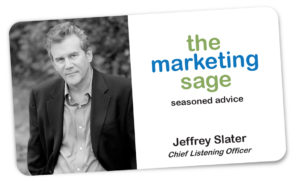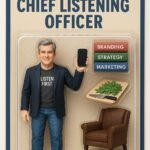Throughout my career, the consultant tended to get a bad rap. Sometimes – they deserve it.
I have seen consultants enter a business and create mounds of slides without clear takeaway or insights. On some occasions, the consultants had a highly focused job and were enormously successful at achieving the stated deliverables and goals.
See this example from an approach called Rapid Results from Schaffer Consulting in Stamford, CT. This consulting gig was a 100-day sprint by sales that was quite effective.
I have been reflecting on a project I did more than two years ago and the essence of my role as a consultant to them.
An effective consultant offers a company a rare opportunity to learn how employees and customers truly see them. Consultants do this by looking from the outside, in and reporting fearlessly.
Interviews with employees and customers can reveal information that a senior team may never hear. Often, there can be a frankness in these discussions. What is said is held in confidence and only shared in the aggregate. Themes emerge. Revelations occur. An opportunity to improve employee and customer satisfaction becomes clear.
When was the last time someone spoke confidentially with your associates? Imagine an outsider asking about the culture and productivity in general?
What would this information be worth when an employee and customer raise issues about satisfaction, productivity and value – and some useful recommendations could help you on a path toward improvement?
A Case Study
Note: I changed some of the details due to confidentiality restrictions in my contract. But the themes at the end are relevant and, hopefully, useful to you.
Situation and Background:
A company in the Southwestern part of the U.S. struggled with flat growth for four consecutive years.
“We are plain stuck. Things are flat. It is like we have no fuel in our tank anymore, said the CEO” That’s how Jim McDonald (not his real name) explained the situation to me.
They could not figure out how to get themselves moving forward and growing again. The client’s industry was booming, but the company was no longer getting a fair share of the pie. The product they sold was not outdated – although how they went to market was stale. Something internally wasn’t working – and they suspected their marketing was out of date.
The Consulting Challenge:
They hired theMarketing Sage to analyze the situation, speak to current and lost customers, and a representative sample of employees. They wanted me to help them uncover if they had a marketing problem or something more fundamental. My deliverable was a report and a series of recommendations to help them fix what wasn’t working. The job was to draw a clear picture and provide a road map to get unstuck.
The Work:
We interviewed a dozen current customers, six customers no longer bought from the business, and about 75 employees in focus groups. The interviews took about ten weeks to complete. My team and I also audited many of the processes and procedures to get a first-hand look at how they got things done.
The best insights and learning came from employees and a few customers speaking to us entirely off the record. They were brutally honest but wanted to help the company and its leadership succeed.
The Problem Emerged:
We identified several fundamental problems that involved employee frustrations, unpredictable communications, unclear roles and responsibilities, old-school marketing objectives and tactics, ineffective sales management and compensation, and some leadership voids.
The recommendations were painful for the leaders to read, but there wasn’t anything we told them that they didn’t already know. They were too busy running the business – to stop and acknowledge what they knew and find a path forward. As consultants shared, we were right in front of them, but they didn’t want to believe it.
Outcome:
Within six months, they were back in a growth mode with year over year increases in units and volume. We helped refuel their momentum.
The outcome was like hitting the refresh button. They needed some realignment of the business’ structure. We shed light on recognizing that employees were demotivated and needed an opportunity to run the company leveraging their knowledge. The middle managers were getting in the middle of progress, agility, and action. The company had to shift from a command and control to having small teams focus on discreet market segments. As consultants without bias, we could be the voice of both employees and customers to leadership.
As you might expect, we met some resistance from individual members of the leadership team. What could we possibly know about their business and industry without experience in that field? Yet – most of the senior team knew that we were reframing what they instinctively knew.
Ten Insights from This Assignment
Nothing we reported to management was magical. There wasn’t any secret sauce. But as outsiders, we could listen without prejudice. Our blueprint was also practical with exact, discreet steps.
We offered about ten key themes that were as much about culture as communications or marketing.
Here are those themes we shared:
- Unclear expectations – “Often, I don’t know what I should be doing.”
- Employees frustration – “Just let me use my skills and get out of my way -stop micromanaging everything.”
- Lack of authentic praise for great work – “It would be nice to hear some praise for a job well done.”
- Compassion for workers as human beings – “don’t talk about us as a family and lack the compassion to sit with people and show you care.”
- No career development path – “You say you care about me – so show me you care about my future too.”
- Take my feedback seriously – even if you don’t use it – “Ask my opinion now and then.”
- No connection from my work to our mission – “I feel like I’m not sure where we are ultimately heading.”
- Honesty about changes – “Please don’t B.S. me that nothing will change. Treat us as adults, tell us the truth. We can handle it.”
- Consistent cadence of communications – “Some consistency of updating us would be a breath of fresh air. When we don’t hear from management, we get worried.”
- Marketing stuck in 1990. “We aren’t up to date with how companies market themselves today. We were still living in a world that has passed us by.”
Consultants, like any professional, come in all stripes. Hire someone who will be brutally honest and will advocate for your customers and employees.
Need help with an outsiders perspective on your business?
I can help. You can set up a time chat with me about your marketing challenges using my calendar. Our initial conversation is free. You talk, I listen. Email me jeffslater@themarketingsage.com or call me. 919 720 0995. Visit my website at www.themarketingsage.com. Let’s explore working together today.

Photo by Andrew Ridley on Unsplash




